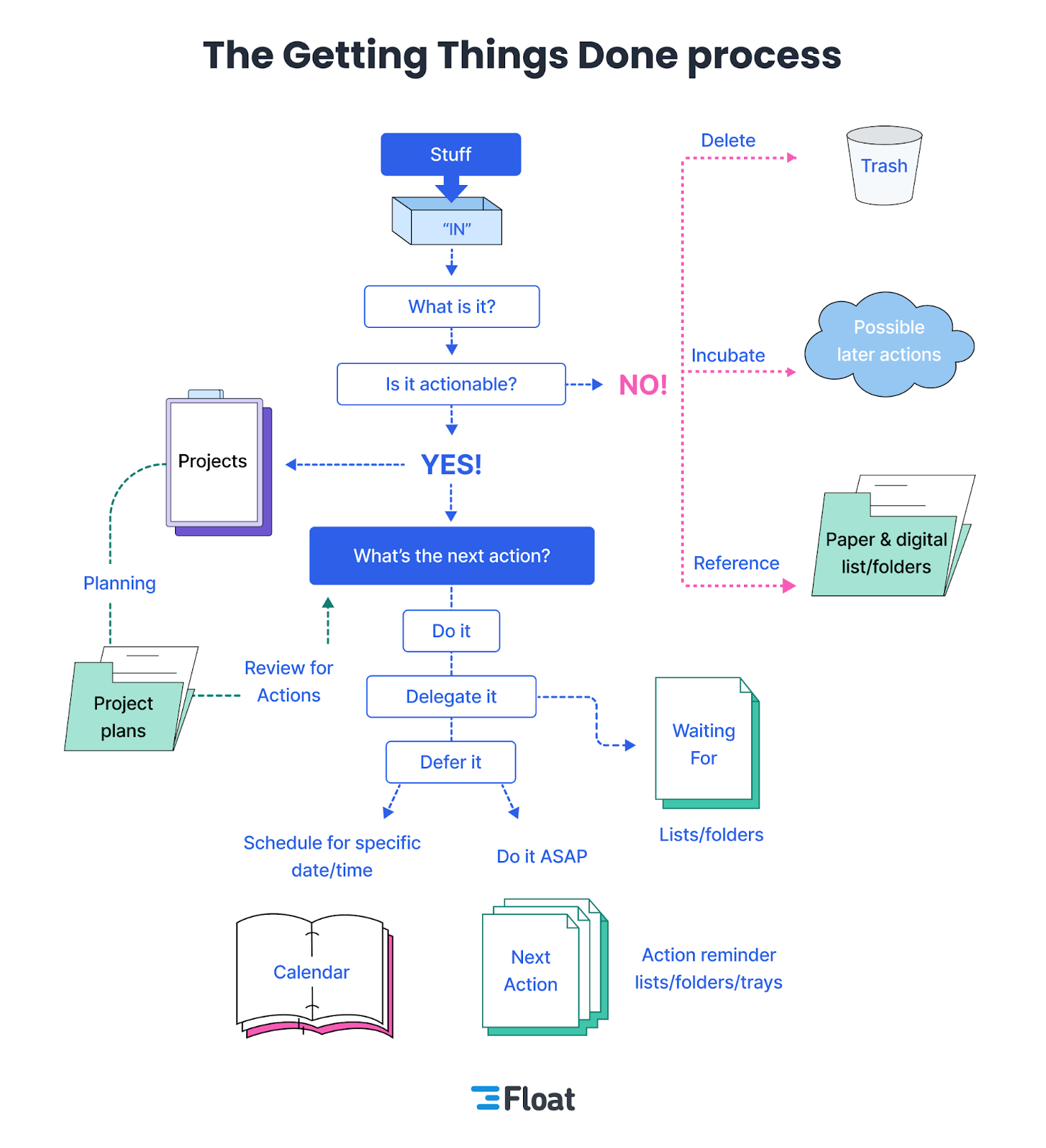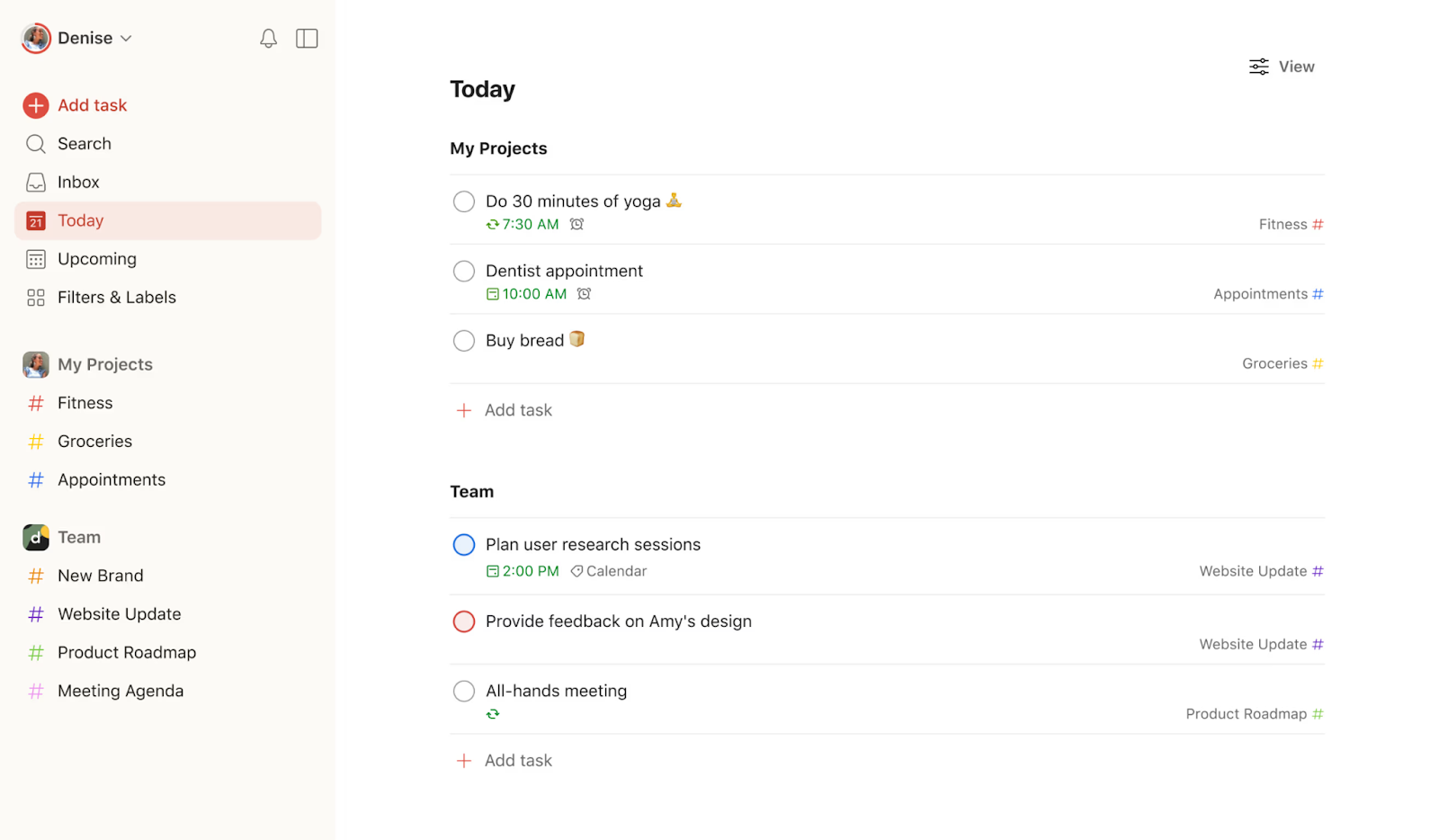The GTD (getting things done) method is an organizational workflow designed to optimize productivity and reduce cognitive load. It uses a trusted system to capture tasks, fostering a clearer mind and effective decision-making. By identifying what is actionable and focusing on the Next Action, the GTD method helps inexorable project planning and time management.
This technique aims to minimize stress management by dividing each project into manageable tasks and planning them accordingly. Emphasizing On Capturing every obligation or commitment into a reliable system allows an individual to focus on performing tasks rather than remembering them, thereby boosting productivity.
Introduction to the GTD method
The GTD method, short for “getting things done,” is a time management method developed by David Allen. It’s designed to boost productivity and cut down on mental clutter through smart planning and organization. At the heart of the GTD method is the idea of turning tasks into steps you can actually take, figuring out the next move, and keeping a reliable system.
Using the GTD method helps people get better at planning projects and making decisions. It also eases stress by setting up a clear process and making sure every task is noted in an orderly way.
What is the GTD method?
The GTD method, or getting things done, is a way to manage time and get more done that helps with making choices, handling stress, and planning. Created by David Allen, it’s all about making every task, no matter the size, into something you can handle and act on. The big goal is to lighten the mental load, leading to better project planning and organization.
This method has five parts: capture, clarify, organize, reflect, and engage. You start by writing down all tasks in a place you trust. Then you make each task clear to figure out the next step and put it in order. Regular check-ins and updates are the reflected part, and the final engagement part is when you actually do the task. This flow helps you do more and worry less.
The origin of the GTD method
David Allen came up with the GTD method to help with productivity and stress management. Allen’s approach is all about making things you have to do into tasks you can act on, which leads to clearer thinking and less mental clutter.
There are five main steps in this method: capture, clarify, organize, reflect, and engage. You write down everything you need to do in a place you can count on, which makes sure you do things efficiently. The main aim is to help users figure out the next step for planning their projects, which improves time management and how well things are organized.
The five pillars of GTD method

The GTD method stands on five pillars: Capture, Clarify, Organize, Reflect, and Engage. These steps build a solid base for managing time and getting things done. ‘Capture’ is about gathering all tasks in one spot. ‘Clarify’ means figuring out what to do next.
‘Organize’ sorts tasks into groups that make sense. ‘Reflect’ is looking over your tasks regularly, which helps clear your mind. ‘Engage’ is when you start working, using what you’ve planned to manage stress and get things done.
Capture: Collecting what has your attention
The first step is ‘Capture’, where you grab everything that needs your attention. This could be emails, tasks, or just ideas. It makes decision-making easier and helps manage stress.
A good system for capturing should be simple and regular, so it becomes second nature to note down everything that’s on your mind. This leads to clear ‘Next Actions’ and fits right into your workflow.
Clarify: Processing what it means
‘Clarify’ is about understanding your tasks and breaking them down. You decide the order of actions, which helps with stress and makes decisions clearer.
Time management is crucial here. You prioritize tasks to work more efficiently. A good system for capturing and organizing leads to a smoother workflow and better productivity.
Organize: Putting it where it belongs
Good organization is key to productivity. It eases your mind, helps make better decisions, and manages stress. A trusted system helps you organize tasks and plan your ‘Next Action’.
Careful planning guides all tasks and ensures you use your time well. Capturing ideas as they come also helps with organization. The goal is to work smarter, not harder.
Reflect: Reviewing frequently
‘Reflect’ means checking your tasks often. This helps you see if you’re on track with your planning. It helps decide the ‘Next Action’, clears your mind, and aids decision-making.
Your trusted system is important here too. It includes organization, workflow, and capturing items. This boosts productivity and helps with stress.
Engage: Simply doing
Productivity and time management are Key Elements in achieving your tasks and project planning. Simple planning can reduce your cognitive load and enhance decision-making. First, capture your task, break it down into actionable components, and decide the Next Action. This is how you create your trusted system.
Proper organization and workflow are essential for stress management. Seeking the most efficient use of resources maximizes productivity and reduces downtime. Keep your project planning flexible and adaptable to change, as it is a dynamic process requiring constant adjustment.
Benefits of implementing the GTD method

The GTD (getting things done) method promotes increased productivity and stress management. Establishing a trusted system for capturing Tasks, It Ensures that no task falls through the cracks. It zeroes down the cognitive load, allowing To Focus more on decision-making and Next Action steps.
Furthermore, GTD enhances time management and organization. Allowing to plan projects Effectively, It Refines workflow and helps stay organized. By transforming tasks into actionable items, GTD significantly boosts efficiency. Finally, it helps in structuring the daily routine better by allocating tasks and projects.
Increased productivity
Productivity can be significantly enhanced through effective project planning and organization. This involves capturing every task and assigning each an actionable next step in your trusted system. Such a streamlined workflow aids in reducing cognitive load, thereby boosting decision-making abilities and Time management Skills.
Furthermore, engaging with stress management strategies can contribute to increased productivity. Keep in mind the following tips:
- Maintain a well-structured project plan.
- Stay organized with a system that suits your work style.
- Focus on one task at a time to reduce cognitive load and improve performance.
Reduced stress levels
Reducing stress levels significantly improves productivity and Decision making. This requires implementing actionable steps in your workflow and trusted system, allowing for efficient project planning and time management. Such an organized working style lessens cognitive load, enabling smoother transitions between tasks.
Key strategies include:
- Maintaining a comprehensive capture of all tasks and obligations.
- Clearly defining the next action for each item.
- Implementing effective stress management techniques.
Such strategic planning and organization will ensure that all projects are completed on time, reducing stress and increasing output.
Improved focus and clarity
Enhancing focus and clarity is essential in elevating productivity. A trusted system reduces the cognitive load and streamlines decision-making. It involves capturing tasks strategically and sequencing them in a workflow. This systematic organization leads to a clear path highlighting the Next Action, enabling effective time management.
Another essential element is project planning, That aims At reducing stress management and boosts productivity. Offering actionable steps aids in maintaining clarity in the course of the project, facilitating improved focus. To Add, habitual planning and organizing tasks make them less complex and more manageable to handle, thereby enhancing overall focus and productivity.
How to implement the GTD method in your agency

The GTD (getting things done) method improves productivity through effective time management and planning, starting with capturing all tasks in a trusted system. This involves outlining all individual actions necessary for project completion, thus lightening Cognitive Load and speeding up decision-making.
The next step in the GTD workflow includes considering each task's status in the bigger picture of project planning and Organization, And establishing the next actionable task. This reduces stress and allows for smoother transitions between tasks.
By investing in this approach, your agency can streamline workflow, enhance productivity, and foster a calm and controlled environment.
Step-by-step guide to implementing GTD
Begin implementing GTD (getting things done) by first capturing all the tasks that require your attention. Whether large or small, break down each project into actionable steps. Decide what the Next Action should be for each task thus reducing cognitive load and streamlining your decision-making process.
Organize these tasks within a trusted system. It could be an app or a physical planner, choose what fits best to your needs. This system not only helps in project planning but also leads to effective time management and increases productivity. Remember, the key to successful GTD implementation is regular reviewing and updating of your task list.
Common challenges and how to overcome them
Challenges including productivity issues, stress management, and maintaining a trusted system often hamper organizational workflow. To overcome these, an actionable project planning is key, breaking down complex tasks into simpler subtasks. This reduces the cognitive load, aids decision-making, and improves time management.
Key strategies include:
- Prioritizing tasks and focusing on the next Action, Greatly Enhancing Productivity.
- Regularly capturing information to keep the system updated.
- Investing time in proactive Planning, Which Can alleviate stress management issues.
Tools to help you implement the GTD method
Using the right tools makes the GTD method a breeze. They’re great for managing tasks, planning projects, and organizing your workflow. These tools, usually digital, are your go-to system for keeping track of what you need to do, lightening your mental load, and making better choices.
They’re not just for getting more done; they’re also for keeping calm. They help you split your work into doable ‘Next Action’ steps. With everything laid out, you manage
your time well and do your best work.
Bonsai: Manage your tasks in one platform

Bonsai is a comprehensive business management platform that simplifies task management by bringing all your work into one place. It's designed to keep everything organized and accessible, helping you to deliver work on time and maintain control over your projects.
Evernote: A versatile tool for GTD

Evernote is a top pick for GTD with its trusted system, time management, and productivity perks. It lets you sort out your work with features that cut down on mental clutter and keep things tidy. It’s a big help in planning projects by letting you set up your workflow just how you like it, making decisions easier.
You can keep stress in check by listing out tasks in Evernote, pointing out the next step for each project. Its capture feature lets you save ideas, tasks, or files for later, really adding to your daily planning.
Todoist: Prioritize your tasks effectively

Todoist helps you plan projects and keep things in order, acting as your reliable system for tasks. It lets you lay out steps, keep up with deadlines, and smooth out your workflow. By making each next step clear, it takes a load off your mind and helps you make smart choices.
Todoist isn’t just about writing down tasks; it boosts how much you get done. It’s a strong ally for staying calm and managing your time. All in all, it gives you a full plan of attack. People often say they get more done and feel less frazzled with Todoist.
Microsoft OneNote: Organize your notes and tasks

Microsoft OneNote is the go-to for folks and businesses for keeping organized and planning projects. Its easy-to-use setup helps you handle mental clutter by giving you a neat place to jot down key points, tasks, or full project details. Its top-notch productivity features mean you can sort out your workflow, ease stress, and make better decisions.
OneNote’s standout features include time management setups, helping you figure out the next move in your schedule, and productivity tools to stay on course. Its advanced planning options offer a hands-on way to handle tasks with ease.
Conclusion: Embrace the GTD method for better productivity
In conclusion, embracing the GTD method can dramatically improve your productivity, time management, and stress management. This method helps in project planning and organization by decreasing your cognitive load and enhancing your decision-making capability.
The process involves capturing every actionable task in a trusted system, thus creating a smooth workflow which allows you to focus on deciding the






